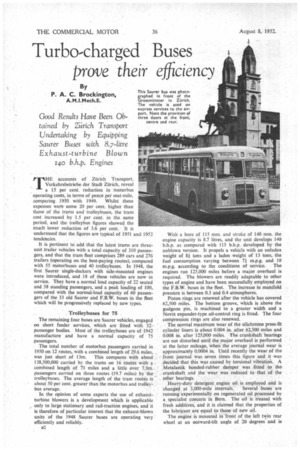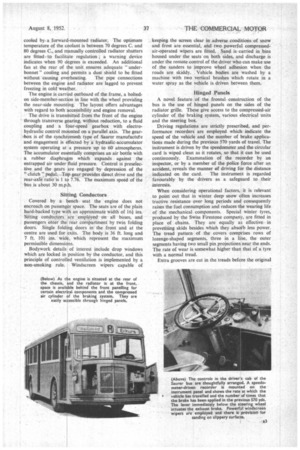Turbo-charged Buses
Page 36

Page 37

Page 38

If you've noticed an error in this article please click here to report it so we can fix it.
prove their efficiency By P. A. C. Brockington,
A.M.I.Mech.E.
Good Results Have Been, Obtained by Ziirich Transport Undertaking by Equipping Saurer Buses with 8.7-litre Exhaust-turbine Blown 140 b.h.p. Engines
HE accounts of Zurich Transport, Verkehrsbetriebe der Stadt ZUrich, reveal a 15 per cent. reduction in 'motorbus operating costs, in terms of pence per seat-mile, comparing 1950 with 1949. Whilst these expenses were some 20 per cent, higher than those of the trams and trolleybuses, the tram cost increased by 1.5 per cent. in the same period, and the trolleybus figures showed the much lower reduction of 3.6 per cent. It is understood that the figures are typical of 1951 and 1952 tendencies.
It is pertinent to add that the latest trams are threeunit trailer vehicles with a total capacity of 310 passengers, and that the tram fleet comprises 289 cars and 276 trailers (operating on the best-paying routes), compared with 55 motorbuses and 40 trolleybuses. In 1948, the first Saurer single-deckers with side-Mounted engines were introduced, and 18 of these vehicles are now in service. They have a normal load capacity of 22 seated and 58 standing passengers, and a peak loading of 100, compared with the normal-load capacity of 60 passengers of the 33 old Saurer and F.B.W. buses in the fleet which will be progressively replaced by new types.
Trolleybuses for 75 The remaining four buses are Saurer vehicles, engaged on short feeder services, which are fitted with 32passenger bodies. Most of the trolleybuses are of 1942 manufacture and have a normal capacity of 75 passengers.
The total number of motorbus passengers carried in 1950 on 12 routes, with a combined length of 29.6 miles, was just short of 13m. This compares with about 138,500,000 carried by the trams on 16 routes with g combined length of 73 miles and a little over 7.3m. passengers carried on three routes (19.7 miles) by the trolleybuses. The average length of the tram routes is about 50 per cent. greater than the motorbus and trolley. bus average. In the opinion of some experts the use of exhaustturbine blowers is a development which is applicable Only to large stationary and rail-traction engines, and it is therefore of particular interest that the exhaust-blown units of the 1948 Saucer buses are operating very ' efficiently and reliably.
With a bore of 115 mm. and stroke of 140 mm. the engine capacity is8.7 litres, and the unit develops 140 b.h.p. as compared with 115 bhp, developed by the unblown version. It propels a vehicle with an unladen weight of 81 tons and a laden weight of 13 tons, the fuel consumption varying between 7i m.p.g. and 10 m.p.g. according to the conditions of service. The engines run 125,000 miles before a major overhaul is required. The blowers are readily adaptable to other types of engine and have been successfully employed on the F.B.W. buses in the fleet. The increase in manifold pressure is between 0.3 and 0.4 atmospheres.
Piston rings are renewed after the vehicle has covered 62,500 miles. The bottom groove, which is above the gudgeon pin, is machined to a greater width and a Novix expander-type oil-control ring is fitted. The four • compression rings are also renewed.
The normal maxirnum wear of the silichrome press-fit cylinder liners is about 0.004 in. after 62,500 miles and 0.008 in. after 125000 miles. The. crankShaft bearings are not disturbed until the major overhaul is performed at the latter mileage, when the average journal wear is approximately 0.0004 in. Until recently the wear of the front journal was seven times this figure and it was decided that this was caused by torsional vibration. A
• Metalastik bonded-rubber damper was fitted to the crankshaft and the wear was reduced to that of the other bearings. Heavy-duty detergent engine oil is employed and is :changed at 3,000-mile intervals. Several buses are running experimentally on regenerated oil processed by a specialist Concern in Bern. The oil is treated with fresh additives, and it is claimed that the properties of the lubricant are equal to those of new oil.
The engine is mounted in front of the left twin rear wheel at an outward-tilt angle of 20 degrees and is cooled by, a forward-mounted radiator. The optimum temperature of the coolant is between 70 degrees C. and 80 degrees C., and manually controlled radiator shutters are fittedto facilitate regulation ; a warning device indicates -when 90 d grees is exceeded. An additional fan at the rear of tie unit ensures adequate " underbonnet " cooling an4 permits a dust shield to be fitted without ' causing Or heating. The pipe connections between the engine nd radiator are lagged to prevent freezing in cold weather.
The engine is carried outboard of the frame, a boltedon side-member-section in line with the wheel providing the near-side mounting. The layout offers advantages with regard to both accessibility and engine removal.
The drive is transmitted from the front of the engine through transverse g aring, without reduction, to a fluid coupling and a fur-speed gearbox with eIectrohydraulic control mclunted on a parallel axis. The gear-box is of the synchr mesh type of Saurer manufactze and engagement is elifected by a hydraulic-accumulator system operating at a pressure up to 60 atmospheres. The accumulator ess ntially comprises an air bottle with a rubber diaphragm which expands against the entrapped air under fluid pressure. Control is preselective and the gears are engaged by depression of the " clutch " pedal. -Top-gear provides direct drive and the rear-axle ratio is 1 to 7.76. The maximum speed of the bus is about 30 rn.p.s.
Si tin Conductors Covered by a ench seat the engine does not encroach on passeng r space. The seats are of the plain hard-backed type with an approximate width of 161 ins. Sitting conductors tire employed on all buses, and passengers enter the rear compartment by twin folding doors. Single folding doors in the front and at the centre are used for rxits. The body is 36 ft. long and 7 ft. 101 ins, wide, which represent the maximum permissible dimensi ns.
Bodywork details of interest include drop windows which are locked in position by the conductor, and this principle of control' d ventilation is implemented by a non-smoking rule. Windscreen wipers capable of keeping the screen clear in adverse conditions of snow and frost are essential, and two powerful compressed • air-operated wipers are fitted. Sand is-carried in bins housed under the seats on both sides, and discharge is under the remote control of the driver who can make use of the sanders to improve wheel adhesion when the roads are skiddy. Vehicle bodies are washed by a machine with two vertical brushes which rotate in a water spray as the vehicle is driven between them.
Hinged Panels A novel feature of the frontal construction of the bus is the use of hinged panels on the sides of the radiator grille. These give access to the compressed-air cylinder of the braking system, various electrical units and the steering box.
Driving regulations are strictly prescribed, and performance recorders are employed which indicate the speed of the vehicle and the number of brake applications made during the previous 570 yards of travel. The instrument is driven by the speedometer and the circular card is wiped clean as it rotates, so that it can be used continuously. Examination of the recorder by an inspector, or by a member of the police force after an accident, reveals the manner of driving for the distance indicated on the card. The instrument is regarded favourably by the drivers as a safeguard to their interests.
When considering operational factors, it is relevant to point out that in winter deep snow often increases tractive resistance over long periods and consequently raises the fuel consumption and reduces the wearing life of the mechanical components. Special winter tyres, produced by the Swiss Firestone company, are fitted in place of chains. They are equally as effective preventing skids besides which they absofb less power. The tread pattern of the covers comprises rows of lozenge-shaped segments, three in a line, the outer segments having two small pin projections near the ends. The rate of wear is somewhat higher than that of a tyre with a normal tread.
Extra grooves are cut in the treads before the original
pattern. has worn smooth. Retreading of tyres is not an accepted practice, and a decision on its advisability awaits the results of tests which are now being made.
• Brake facings are renewed every 30,000 miles with Furka moulded material, which is impregnated with lead. Although the friction coefficient of this material is lower than that of the best woven facings, its wearing
life is appreciably longer. Exhaust-restrictor braking is employed on all the buses, and preliminary retardation by this means is regularly practised by the drivers for normal traffic stops and so on. On long descents, the _system is particularly beneficial in reducing the load on the friction brakes, which consequently run'. at a lower temperature.
Encouraging Use 'From these observations it will be gathered that, in most instances, application of the foot brake is made after the restrictor brake has been brought into action and the overall efficiency of the two brakes is higher than normal. The ease with which restrictor braking can be applied by a lever under the steering wheel further encourages its use.
Routes are divided into stages of 765 yards (700 metres) and the same faros system applies to all services. A minimum fare of 4d. is charged for distances up to three stages, a 6d. ticket is issued for three to five stages and an 8d. ticket entitles the holder to travel up to nine stages. A charge of 10d. is made for any distance of more than nine stages.
Rebate, concession and season tickets form a large percentage of the total issued, the proportion in nutneri
eat value being about 70 per cent Books% of tickets covering up to 30 journeys are available at reduced cost, cheap tickets are issued to workmen in books of 10, 12, 20 and 22 tickets, and concessions are also made to school children, post-office workers and the police. Season tickets can be obtained for periods of a month, six months and a year. Claims can be made on tickets which are surrendered before expiry, and included in the undertakings accounts is a table showing revenue reduction on repayments, the total for 1950 being over Li ina. These applied to all types of ticket issued.
Strict Account A strict account of all accidents is kept and details published of injuries received by the staff and members of the public. In 1950, the collisions on the public roads per 62,000 miles (100,000 km.) were trams : 3.5; trolleybuses : 5; motorbuses ; 4.1.
The number of inhabitants of Zurich increased from around 325,000 in 1936, to 392,000 in 1950, during which time the revenue per vehicle-mile fluctuated in a general upward trend.from Is. 4d. in 1936, to a maximum of about 2s. 2id. in 1945 and back to 2s. Old. in 1950. The proportion of cost to revenue was about 80 per cent. in 1936, dropped to 70 per cent. in 1945, rose to 90 per cent. in 1949 and fell to 87 per cent. in 1950.
In the same period the vehicle-miles per, inhabitant decreased from 41 in ,1936, to 32 in 1943, and ,rose to nearly 42 in 1950. Profits showed a progressive increase of film. in 1940 to slightly under 421m. in 1950. Data for 1951 are not yet available, but approximately correspond to the 1950 figures.




















































































